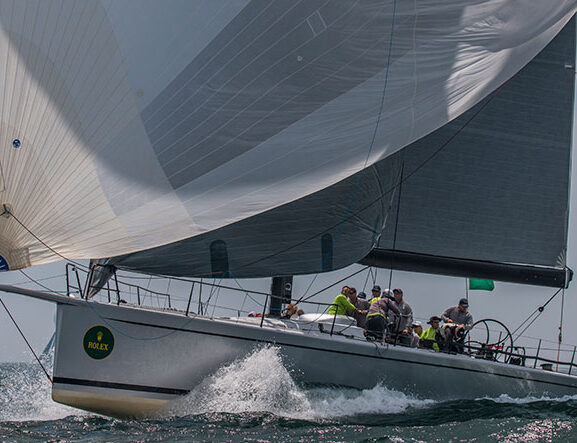NEWPORT, R.I. — Faster boats and advanced weather forecasting technology have dramatically changed how sailors approach long ocean races such as the Transatlantic Race 2019, which will start from Newport, R.I., on Tuesday, June 25, 2019, and finish off the Royal Yacht Squadron's iconic castle in Cowes, England.
A century ago, ocean racing was a reactive sport, sailors took what Mother Nature dished out as it came. Now, bigger and faster boats enable teams to attack a course, aggressively searching for the strongest and most favorable winds. Of course, it’s not without risk.
In the Transatlantic Race 2015, the Prospector team found itself on the leading edge of a powerful weather system for much of the 3,000-mile passage from Newport, R.I., to England.
2019 Pic 2
“We always had good pressure and knew when we needed more it was just off to our left,” says Paul McDowell, one of a consortium of owners based out of Eastern Long Island’s Shelter Island Yacht Club. “Playing with that weather system, which we took to calling ‘poking the bear,’ was tricky though. For one 36-hour period we got a little too close and ended up sailing in some really difficult conditions; 40- to 50-knot winds with huge breaking seas. In those 36 hours, we learned a lot about the boat, our crew and what not to do next time. We all look back on that now with mixed degrees of fondness and relief to have survived it.”
For ocean racers, the relief peaks when crossing the finish line, but the fondness grows slowly and eventually becomes the predominant emotion. Which explains why the Prospector team, with more than two years to reflect on that race, was among the first boats to officially sign-up for the Transatlantic Race 2019 and continue a tradition that dates back to the first transatlantic sailing competition, which started from New York Harbor on Christmas Day 1866.
The Transatlantic Race 2019 will be the 31st race between Europe and the United States organized, at least partially, by the New York Yacht Club. The Transatlantic Race 2019 is organized by the Royal Yacht Squadron, the New York Yacht Club, the Royal Ocean Racing Club and the Storm Trysail Club.
“Our original plan was to be one and done,” says McDowell of the Prospectorsyndicate. “Indeed, we thought we might charter a boat, do only the Transatlantic and then have bragging rights in the Shelter Island Yacht Club bar for the next 10 years.”
2019 Pic 3
That changed quickly once the team found a boat—a 17-year-old Carroll Marine 60 (at left and immediately above) perfectly suited for long offshore races. The campaign stretched to include races in Europe and the Caribbean in addition to all the classics in the Northeastern United States.
After two successful seasons, some of the original partners decided they’d had enough. But McDowell, Larry Landry and David Siwicki weren’t quite sated. So they upgraded to a newer boat and set their sights on the next race across the Atlantic.
“Over the past several years we have been methodically checking off our ‘bucket list’ of the world's great ocean races,” says McDowell. “But none compare to the challenge presented by racing full tilt across the North Atlantic. For a predominantly Corinthian team like ours, the Transatlantic Race 2019 really represents the pinnacle of offshore racing: it's tough, it's really long and it's very competitive. There really is something to say about racing across the full breadth of an ocean, from one continent to another.”
While the new boat, a Mills 68 (top photo), is just marginally longer than the first boat—and the same weight—it’s a significantly more powerful raceboat and presents some new challenges.
“It's in another class entirely from nearly every standpoint: size, complexity, technology and power,” says McDowell. “It’s really a quantum leap from our last boat. We honestly believe that the boat we are sailing now is one of the finest offshore boats of its size anywhere in the world, and we are working at making her better. The challenge for us as a team is to learn how to get the most out of her in all conditions, particularly heavy air running like we saw in the last Transatlantic Race, without breaking the boat. We are getting the hang of it having won last year's Pineapple Cup against a very talented Wizard team, and setting the course record and winning overall in last summer's Marblehead to Halifax Ocean Race.”
In layman’s terms, that means they’ll spend more time poking a larger bear. But the unique rewards of the Transatlantic Race are more than worth it.
“There are so many unique moments, packed into 10 to 14 days at sea, that you can't possibly experience in the two to four days it takes to do most major offshore races," says McDowell. "A beautiful sunrise a thousand miles from land bracketed by leaping dolphins, a huge wave looming behind the boat with a breaking crest, the boat surfing hard with spray everywhere, eating a hot freeze-dried meal on deck while laughing with your watch mates about some silly movie line from Talladega Nights, the stars touching literally horizon to horizon with zero light other than the glow of the instruments, and your warm bunk after a cold, wet watch.”
A Notice of Race for the Transatlantic Race 2019 can be found on the race's website, https://transatlanticrace.org/,along with entry information and a full archive of race documents, results, blogs, photos and videos from the 2011 and 2015 races.
Follow us on Facebook at www.facebook.com/TransatlanticRace
Photo credits: © Daniel Forster/NYYC (2), Courtesy of the Prospector Syndicate (2)

